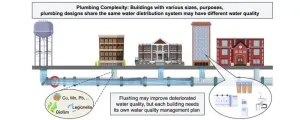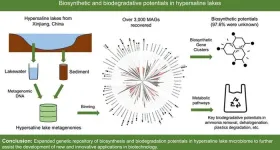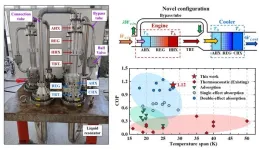(Press-News.org) While newly approved drugs for Alzheimer’s show some promise for slowing the memory-robbing disease, the current treatments fall far short of being effective at regaining memory. What is needed are more treatment options targeted to restore memory, said Buck Assistant Professor Tara Tracy, PhD, the senior author of a study that proposes an alternate strategy for reversing the memory problems that accompany Alzheimer’s disease and related dementias.
Since most current research on potential treatments for Alzheimer’s focuses on reducing the toxic proteins, such as tau and amyloid beta, that accumulate in the brain as the disease progresses, the team veered away from this route to explore an alternative. “Rather than trying to reduce toxic proteins in the brain, we are trying to reverse the damage caused by Alzheimer’s disease to restore memory,” said Tracy. The findings appear in the February 1 issue of The Journal of Clinical Investigation.
The work hinges on a protein called KIBRA, named because it is found in the kidney and the brain. In the brain, it is primarily localized at the synapses, which are the connections between neurons that allow memories to be formed and recalled. Research has shown that KIBRA is required for synapses to form memories, and Tracy’s team has found that brains with Alzheimer’s disease are deficient in KIBRA.
“We wondered how the lower levels of KIBRA affected signaling at the synapse, and whether understanding that mechanism better could yield some insight into how to repair the synapses damaged during the course of Alzheimer’s disease,” said Buck Staff Scientist Grant Kauwe, PhD, co-first author of the study. “What we identified is a mechanism that could be targeted to repair synaptic function, and we are now trying to develop a therapy based on this work.”
The team first measured the levels of KIBRA in the cerebrospinal fluid of humans. They found that higher levels of KIBRA in the cerebrospinal fluid, but lower levels in the brain, corresponded to the severity of dementia.
“We also found this amazing correlation between increased tau levels and increased KIBRA levels in the cerebrospinal fluid,” said Tracy. “It was very surprising how strong the relationship was, which really points to the role of KIBRA being affected by tau in the brain.” The team is exploring this phenomenon further, in hopes that KIBRA could be used as a biomarker of synaptic dysfunction and cognitive decline that could be useful for diagnosis, treatment planning, and tracking disease progression and response to therapy.
To figure out how KIBRA affects synapses, the team created a shortened functional version of the KIBRA protein. In laboratory mice that have a condition mimicking human Alzheimer’s disease, they found that this protein can reverse the memory impairment associated with this type of dementia. They found that KIBRA rescues mechanisms that promote the resilience of synapses.
“Interestingly, KIBRA restored synaptic function and memory in mice, despite not fixing the problem of toxic tau protein accumulation,” said Kristeen Pareja-Navarro, co-first author of the study. “Our work supports the possibility that KIBRA could be used as a therapy to improve memory after the onset of memory loss, even though the toxic protein that caused the damage remains.”
Along with other treatments that already exist or will come in the future, a KIBRA therapy to repair synapses could be a valuable addition. “Reducing toxic proteins is of course important, but repairing synapses and improving their function is another critical factor that could help,” said Tracy. “That’s how I see this making the biggest impact in the future.”
CITATION: KIBRA repairs synaptic plasticity and promotes resilience to tauopathy-related memory loss
DOI: /10.1172/JCI169064
Other Buck researchers involved in the study are: Lei Yao, Jackson H. Chen, Ivy Wong, Helen Cifuentes, Samah Shah, and Birgit Schilling
Acknowledgements: This work was supported in part through funds from the National Institutes of Health, the Buck Institute Impact Circle, the BrightFocus Foundation, the Forever Healthy Foundation, the Alzheimer’s Association, the Larry L. Hillblom Foundation, an NCRR shared instrumentation grant, the Consortium for Frontotemporal Dementia Research, and the Tau Consortium.
COI: The authors declare no conflict of interest exists.
About the Buck Institute for Research on Aging
At the Buck, we aim to end the threat of age-related diseases for this and future generations. We bring together the most capable and passionate scientists from a broad range of disciplines to study mechanisms of aging and to identify therapeutics that slow down aging. Our goal is to increase human health span, or the healthy years of life. Located just north of San Francisco, we are globally recognized as the pioneer and leader in efforts to target aging, the number one risk factor for serious diseases including Alzheimer’s, Parkinson’s, cancer, macular degeneration, heart disease, and diabetes. The Buck wants to help people live better longer. Our success will ultimately change healthcare. Learn more at: https://buckinstitute.org
END
Buck scientists discover a potential way to repair synapses damaged in Alzheimer’s disease
2024-02-01
ELSE PRESS RELEASES FROM THIS DATE:
Researchers identify critical pathway responsible for melanoma drug resistance
2024-02-01
(Boston)—One of the major challenges in cancer research and clinical care is understanding the molecular basis for therapeutic resistance as a major cause of long term treatment failures. In cases of melanoma, the main targeted therapeutic strategy is directed against the mitogen-activated protein kinase (MAPK) pathway. Unfortunately, in the vast majority of these patients, resistance to MAPK inhibitor therapies develops within one year of treatment.
In a new study from Boston University Chobanian & Avedisian School of Medicine, ...
Pandemic lockdowns and water quality: a revealing study on building usage
2024-02-01
During the COVID-19 pandemic, lower occupancy in buildings led to reduced water use, raising concerns about water quality due to stagnation. Government warnings highlighted increased risks of chemical and microbiological contamination in water systems. Studies showed that reduced usage and stagnation could elevate heavy metal levels and decrease disinfectant effectiveness, affecting microbial growth. To address this, regular fixture flushing was recommended, which temporarily improved water quality but also revealed the complexities of managing building water systems effectively.
In a recent study (https://doi.org/10.1016/j.ese.2023.100314) ...
Exploring the unseen: microbial wonders in earth's saltiest waters
2024-02-01
The study delves into hypersaline lakes in Xinjiang, China, exploring the genetic and metabolic diversity of microbial communities termed "microbial dark matters". Hypersaline lake ecosystems, characterized by extreme salinity, harbor unique microorganisms with largely unexplored biosynthesis and biodegradation capabilities. The research seeks to uncover novel biological compounds and pathways, potentially revolutionizing biotechnology, medicine, and environmental remediation by tapping into the untapped potential of these extremophiles.
A recent study (https://doi.org/10.1016/j.ese.2023.100359) published ...
As cancer therapies improve, more patients with rectal cancer forego surgery
2024-02-01
While surgery to remove rectal cancer can be necessary and lifesaving, it can sometimes come with significant drawbacks, like loss of bowel control. According to a study led by Wilmot Cancer Institute researchers, patients with rectal cancer who respond well to radiation and chemotherapy are increasingly foregoing surgery and opting for a watch-and-wait approach.
The study, published in JAMA Oncology, shows that the number of patients opting out of surgery rose nearly 10 percent between 2006 and 2020. These data reflect a shift toward what ...
Stanford Medicine-led study shows why women are at greater risk of autoimmune disease
2024-02-01
Somewhere between 24 and 50 million Americans have an autoimmune disease, a condition in which the immune system attacks our own tissues. As many as 4 out of 5 of those people are women.
Rheumatoid arthritis, multiple sclerosis and scleroderma are examples of autoimmune disorders marked by lopsided female-to-male ratios. The ratio for lupus is 9 to 1; for Sjogren’s syndrome, it’s 19 to 1.
Stanford Medicine scientists and their colleagues have traced this disparity to the most fundamental feature differentiating ...
Researchers develop highly efficient heat-driven thermoacoustic refrigerator
2024-02-01
Researchers led by Prof. LUO Ercang from the Technical Institute of Physics and Chemistry (TIPC) of the Chinese Academy of Sciences and their collaborators have developed an innovative heat-driven thermoacoustic refrigerator (HDTR) with a novel bypass configuration that significantly improves the efficiency of this technology.
The study was published in Cell Reports Physical Science on Feb. 1.
HDTR is recognized as a new, promising cooling technology with many advantages. For example, it has no moving parts, uses eco-friendly substances (e.g., helium and nitrogen), and is highly reliable. However, its relatively low efficiency ...
Animals: Small, long-nosed dogs live the longest
2024-02-01
Small long-nosed (or dolichocephalic) dog breeds such as Whippets have the highest life expectancies in the UK, whilst male dogs from medium-sized flat-faced (or brachycephalic) breeds such as English Bulldogs have the lowest. The results, published in Scientific Reports, have been calculated from data on over 580,000 individual dogs from over 150 different breeds, and could help to identify those dogs most at risk of an early death.
Kirsten McMillan and colleagues assembled a database of 584,734 individual dogs using data from 18 different UK sources, including breed registries, vets, pet insurance companies, animal welfare ...
Physical activity and cognitive decline among older adults
2024-02-01
About The Study: Physical activity was associated with better late-life cognition, but the association was weak in this systematic review and meta-analysis including 104 studies with 341,000 participants. However, even a weak association is important from a population health perspective.
Authors: Paula Iso-Markku, M.D., Ph.D., of the University of Helsinki, Finland is the corresponding author.
To access the embargoed study: Visit our For The Media website at this link https://media.jamanetwork.com/
(doi:10.1001/jamanetworkopen.2023.54285)
Editor’s Note: Please see the article for additional information, including other authors, author contributions ...
Cerebral cortical surface structure and neural activation pattern among adolescent football players
2024-02-01
About The Study: In this study of 205 adolescent football players and 70 noncontact control athletes, there was evidence of discernible structural and physiological differences in the brains of adolescent football players compared with their noncontact controls. Many of the affected brain regions were associated with mental health well-being.
Authors: Keisuke Kawata, Ph.D., of Indiana University in Bloomington, is the corresponding author.
To access the embargoed study: Visit our For The Media website at this link https://media.jamanetwork.com/
(doi:10.1001/jamanetworkopen.2023.54235)
Editor’s ...
BU professor to serve on the National Academies’ New Voices in Sciences, Engineering, and Medicine Program
2024-02-01
(Boston)—Sabrina A. Assoumou, MD, MPH, the inaugural Louis W. Sullivan, MD, Professor of Medicine, and an associate professor of medicine at Boston University Chobanian and Avedisian School of Medicine, has been selected to serve in the 2024-2026 cohort of New Voices in Sciences, Engineering, and Medicine at the National Academies. Participants are selected in recognition of outstanding achievements and the program provides an opportunity to identify and address pressing concerns for the nation.
New Voices ...



